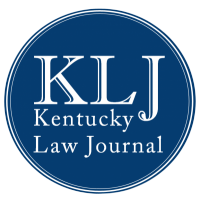Property v. Poverty: Supreme Court Avoids Protecting Tenants from Impending Homelessness as the COVID-19 Pandemic Continues
Blog Post | 110 KY. L. J. ONLINE | Sept 27, 2021
Property v. Poverty: Supreme Court Avoids Protecting Tenants from Impending Homelessness as the COVID-19 Pandemic Continues
By: Holly Couch, Staff Editor, Vol. 110
Challenged by landlords in nearly every state throughout 2020 and 2021, the courts were forced to tackle the moral and legal assessment of the proper balance between landlords’ property interests and the rights of tenants to remain within their home when Congress enacted the federal eviction moratorium in response to the COVID-19 pandemic.[1] When the Centers for Disease Control (CDC) extended the eviction moratorium, courts were then also compelled to interpret whether the CDC had the statutory authority to protect tenants from eviction—knowing that if it did not, tenants throughout their state (and soon the entire country) would be at risk of homelessness.[2]
At the end of August 2021, the Supreme Court ruled to vacate a stay entered by the lower court ending the eviction moratorium extended by the CDC preventing landlords from evicting tenants who were unable to pay due to substantial loss of household income, loss of compensable hours of work or wages, lay-off, or extraordinary out-of-pocket medical expenses during the COVID-19 pandemic.[3] The Court was unwilling to interpret §361(a) of the Public Health Service Act [4] to give the CDC authority to protect tenants from eviction.[5] The majority stated they were additionally unwilling to intrude on the landlord’s fundamental right to exclude as inherent to ownership of private property.[6]
The Supreme Court has historically acknowledged and supported necessary governmental restraints on individual liberties when there is a compelling interest for the common good, general comfort, health, and prosperity of the state.[7] Justice Breyer’s dissenting opinion takes on a “balance of equities,” which is more in line with the governmental compelling interest analysis, while taking into account the realities of those experiencing poverty and at-risk of homelessness.[8] As of August 2021, 6.2 million households owe $16.8 billion in back rent.[9] “The CDC has determined that ‘a surge in evictions could lead to the immediate and significant movement of large numbers of persons from lower density to higher density housing...when the highly transmissible Delta variant is driving COVID–19 cases at an unprecedented rate.”[10]
The majority acknowledges the compelling interest the government has in mitigating the spread of the COVID–19 Delta variant, but calls the eviction moratorium an “unlawful pursuit of desirable ends.”[11] It is concerning that the court is unwilling to find the potential of 11 million renter households at risk of eviction and at risk of becoming houseless compelling.[12] The Supreme Court has illustrated how the United States legal system values private landowner’s right to exclude others more than the protection of vulnerable populations. The realities of homelessness, exacerbated by the pandemic, should be much more compelling to the court than the landlord’s right to exclude.
Why does this structure of understanding rights of individuals force us to choose whether property owners or vulnerable populations should be valued more? What does this say about our inherent understanding of the basic rights of individuals?
At the very least, because of the pandemic and federal eviction moratorium, more people are now involved in conversations about social safety nets, long-term solutions, and economic recovery packages.[13] Prior to the pandemic, the United States was already suffering from an affordable housing crisis, it has only been exacerbated and come into the common vernacular of conversation following the economic crisis in the pandemic. It is time for the courts and legislature to take issues of vulnerable populations (those experiencing poverty and homelessness) as compelling.
[1] See Brown v. Azar, 497 F. Supp. 3d 1270 (N.D. Ga. 2020); Skyworks, Ltd. v. Ctrs. for Disease Control & Prevention, No. 5:20-cv-2407, 2021 WL 911720 (N.D. Ohio June 3, 2021).
[2] Brown, 497 F. Supp. 3d. 1270; Skyworks, Ltd., 2021 WL 911720.
[3] Ala. Ass’n of Realtors v. Dept. of Health & Hum. Servs., No. 21A23, 2021 WL 3783142, at *1, *4–5 (U.S. Aug. 26, 2021).
[4] 42 U.S.C. § 264(a) (2010).
[5] Ala. Ass’n of Realtors, 2021 WL 3783142, at *1, *3–4.
[6] Id. at *4 (citing Loretto v. Teleprompter Manhattan CATV Corp., 458 U.S. 419, 435 (1982)).
[7] Jacobson v. Massachusetts, 197 U.S. 11 (1905); cf. Youngstown Sheet & Tube Co. v. Sawyer, 343 U.S. 579 (1952).
[8] Ala. Ass’n of Realtors, 2021 WL 3783142, at *6 (Breyer, J., dissenting).
[9] Spencer Bokat-Lindell, The Red Tape That Could Cost Millions of Americans Their Homes, N.Y. Times (Aug. 31, 2021), https://www.nytimes.com/2021/08/31/opinion/eviction-moratorium-rental-assistance.html.
[10] Ala. Ass’n of Realtors, 2021 WL 3783142, at *7 (Breyer, J., dissenting) (citing Temporary Halt in Residential Evictions in Communities with Substantial or High Transmission of COVID-19 to Prevent the Further Spread of COVID-19, 86 Fed. Reg. 43244-01 (effective Friday, August, 6, 2021 through October 3, 2021).
[11] Id. at *4 (citing Youngstown Sheet & Tube Co. v. Sawyer, 343 U.S. 579 (1952)).
[12] Adam Liptak & Glenn Thrush, Supreme Court Ends Biden’s Eviction Moratorium, N.Y. Times (Sept. 1, 2021), https://www.nytimes.com/2021/08/26/us/eviction-moratorium-ends.html.
[13] Federal Eviction Moratorium, Nat’l Low Income Hous. Coal., https://nlihc.org/coronavirus-and-housing-homelessness/national-eviction-moratorium.

